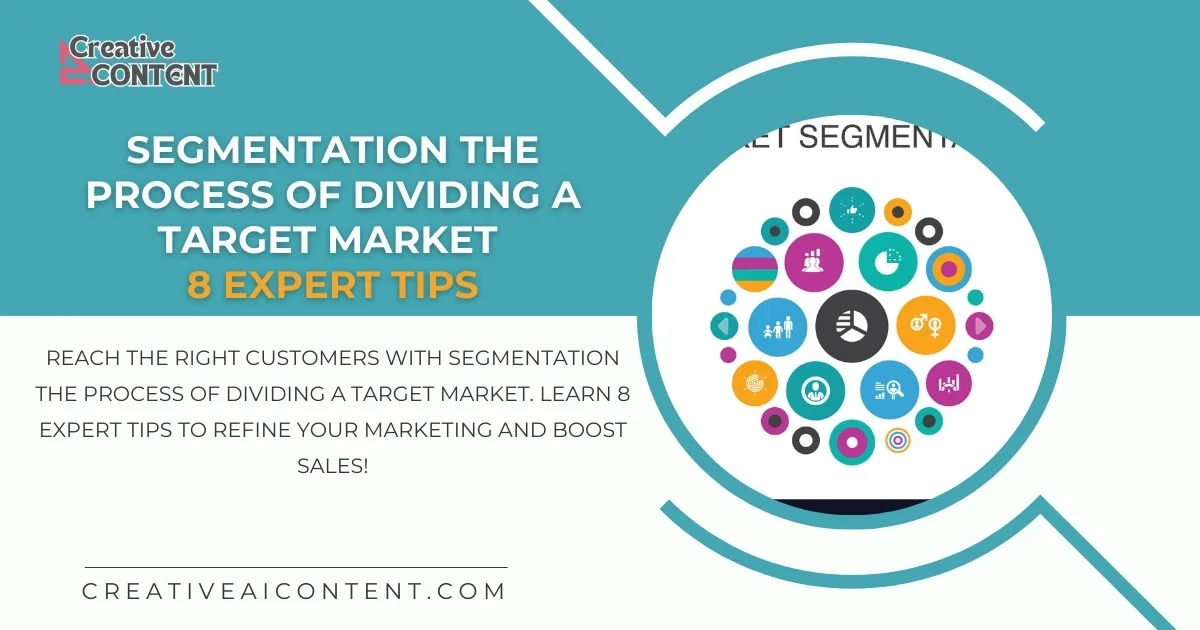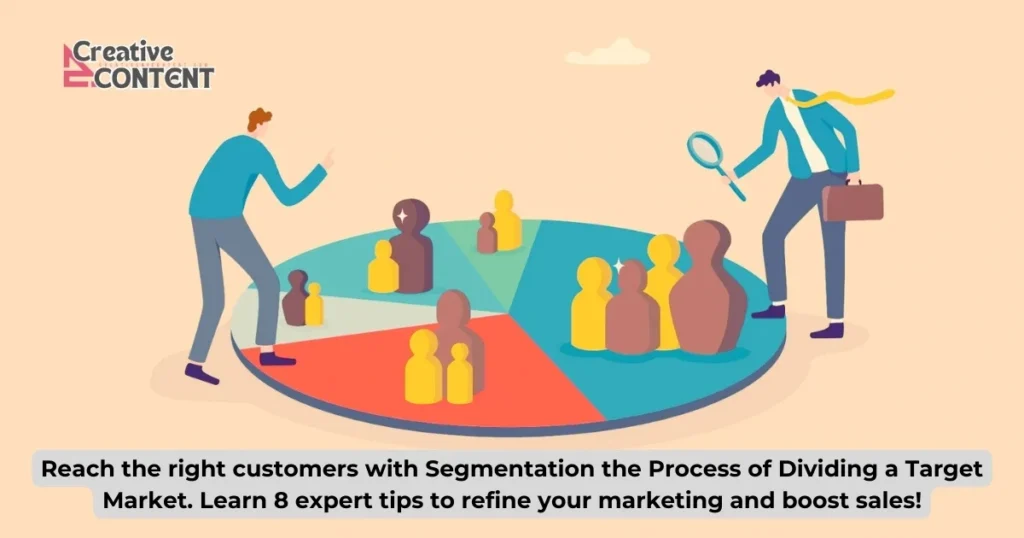Market segmentation is very important for any business. When we talk about Segmentation the Process of Dividing a Target Market, we mean splitting a big group of buyers into smaller groups that share similar needs. This helps companies send the right message to the right people. In this post, we will learn what market segmentation is and why it matters. We will also share eight expert tips to help you use this strategy well. If you are a digital marketing professional, this post is made just for you!

- What is Segmentation the Process of Dividing a Target Market?
- The Importance of Market Segmentation
- Expert Tip 1: Understand Your Audience
- Expert Tip 2: Define Clear Segmentation Criteria
- Expert Tip 3: Leverage Data Analytics and Customer Insights
- Expert Tip 4: Segment by Behavioral Patterns
- Expert Tip 5: Align Segmentation with Business Goals
- Expert Tip 6: Utilize Technology and Automation Tools
- Expert Tip 7: Continuously Monitor and Refine Your Strategy
- Expert Tip 8: Test and Iterate Your Segmentation Approach
- Tools and Techniques for Effective Segmentation
- Conclusion
- FAQs
What is Segmentation the Process of Dividing a Target Market?
Definition & Explanation
Segmentation the Process of Dividing a Target Market means breaking a large market into smaller, similar groups. Think of it as cutting a big cake into small pieces so that each guest gets a piece that suits their taste. By doing this, companies can focus on specific groups and serve them better.
- What does this mean?
It means looking at your customers and deciding which groups they belong to based on things like age, where they live, what they like, and how they act. - Simple Examples:
- Demographic Segmentation: Dividing people by age or gender. For example, toys for kids and gadgets for adults.
- Geographic Segmentation: Grouping customers by where they live, such as cities or countries.
- Psychographic Segmentation: Dividing by personality, values, or interests. For example, adventure lovers versus people who enjoy a quiet life.
- Behavioral Segmentation: Looking at how people act, like their buying habits or how often they shop.
Key Question Addressed
What is segmentation the process of dividing a target market into?
The answer is that it divides the market into segments based on four main criteria:
- Demographics: Age, gender, income, education.
- Geographic Regions: Country, city, or region.
- Psychographics: Lifestyle, personality, values.
- Behaviors: Buying habits, product usage, brand loyalty.
These groups are more similar within themselves and more different from each other. This clear breakdown makes it easier to craft messages that fit each group perfectly. By using this approach, companies can save time and money while making their messages stronger and more appealing.
For more detailed definitions and insights, you can check sources like Investopedia – Market Segmentation and HubSpot – Market Segmentation Guide.
The Importance of Market Segmentation
Market segmentation is a powerful tool for businesses. It lets companies focus on the right people and offer products or services that meet their needs. Here are some important reasons why segmentation matters:
Benefits for Businesses
- Improved Targeting and Messaging:
When you know your audience, you can create messages that speak directly to them. This means customers feel understood and are more likely to act on your offers. - Enhanced Customer Experience:
By dividing the market, you can design better experiences for each group. When customers get what they need, they are happier and stay loyal. - Increased Return on Investment (ROI):
Instead of wasting money on broad, unfocused marketing, you can spend your budget on strategies that really work. This means more sales and better business growth.
Strategic Considerations
Segmentation helps companies plan smarter marketing campaigns. It ensures that every marketing dollar is spent on reaching the right people. This leads to a better allocation of resources and more effective campaigns. When you focus on specific groups, your marketing messages become sharper and more compelling.
By using Segmentation the Process of Dividing a Target Market wisely, you can build stronger relationships with your customers and see real business success.
Expert Tip 1: Understand Your Audience
Conduct Thorough Research
The first step in any segmentation strategy is to know your audience well. Spend time gathering data through surveys, interviews, and analytics. Ask your customers what they like and what they need. Use simple tools like online surveys or chat with them directly.
Identify Key Demographics & Behaviors
- Demographics:
Look at age, gender, income, and education levels. These basic facts help you create a picture of your customers. - Behaviors:
Observe how your customers interact with your products or website. What pages do they visit? What do they buy most often?
Reference
A lot of insights on understanding audiences can be found on sites like HubSpot. These insights help digital marketing professionals use data to make smart decisions.
Expert Tip 2: Define Clear Segmentation Criteria
Set Measurable Variables
To create strong segments, you need clear rules. Decide which factors are most important for your business. Ask yourself:
- Which demographic details matter the most?
- Is the location of my customers important?
- Do their interests change how they buy?
Data-Driven Approach
Use both numbers (quantitative data) and stories (qualitative data) to set your rules. Look at sales data, website visits, and customer feedback. When you combine facts with feelings, you get a complete view of your audience.
Expert Tip 3: Leverage Data Analytics and Customer Insights
Utilize CRM & Analytics Tools
Modern tools make segmentation easier. Use customer relationship management (CRM) software and web analytics tools. These tools help you see patterns in your data. They can show you trends in customer behavior that you might miss by looking manually.
Actionable Insights
Turn the data you collect into action. Ask these questions:
- Which segments are most profitable?
- What changes can I make to serve these groups better?
Using Segmentation the Process of Dividing a Target Market along with good data helps you make decisions that lead to more sales and happier customers.
Expert Tip 4: Segment by Behavioral Patterns
Focus on Customer Actions
Customer actions are a great way to divide your market. Look at how customers use your product or visit your website. Their actions can tell you a lot about what they need.
- Example:
Some customers might visit your website frequently but never buy. Others might purchase only when there is a sale. - List of Actions to Watch:
- Frequency of visits
- Time spent on site
- Purchase history
- Interaction with emails or social media
Tailored Messaging
When you understand these behaviors, you can create messages that match what customers are doing. For example:
- A message for someone who shops on sale could offer a special discount.
- A message for a loyal customer might include a reward program.
This way, your marketing feels personal and relevant.
Expert Tip 5: Align Segmentation with Business Goals
Strategic Alignment
Your segmentation strategy should help you reach your business goals. Think about what you want to achieve:
- Do you want more sales?
- Do you want to build brand loyalty?
- Do you want to reach a new audience?
Align your segmentation with these goals. For example, if your goal is to increase sales, focus on segments that are most likely to buy. If loyalty is your goal, identify customers who already like your brand.
Prioritization
Not all segments are equal. Some groups may offer more value than others. Rank your segments based on:
- Growth potential
- Profitability
- Ease of reach
This will help you focus on the best opportunities and use your resources wisely.
Expert Tip 6: Utilize Technology and Automation Tools
Adopt Advanced Tools
Technology can make segmentation faster and easier. Use advanced tools like AI and machine learning. These can help you quickly sort through data and find patterns. Automation tools can also update your segments automatically as new data comes in.
Efficiency Gains
By using technology, you can:
- Save time on manual work
- Reduce errors in data analysis
- Focus on creative and strategic decisions
This means you can get better results with less effort, making your marketing process smoother.
Expert Tip 7: Continuously Monitor and Refine Your Strategy
Regular Evaluation
Segmentation is not a one-time job. You need to keep an eye on how your segments are doing. Set up key performance indicators (KPIs) and track them regularly. Look for signs that a segment is growing or shrinking.
Iterative Adjustments
The market changes over time. Customer behaviors and preferences can shift. When this happens, adjust your segments. Regular updates ensure that your marketing stays fresh and effective. Always be ready to learn from your data and make improvements.
Expert Tip 8: Test and Iterate Your Segmentation Approach
A/B Testing
Testing different approaches can help you find what works best. Run A/B tests with different segmentation strategies. Compare the results to see which one gives you more sales or better customer engagement.
Feedback Loop
Create a loop of feedback by asking customers what they think. Their opinions can help you fine-tune your approach. Listen to their suggestions and use them to improve your segments over time.

Tools and Techniques for Effective Segmentation
Overview of Available Tools
There are many tools out there to help you with segmentation. Here are a few popular ones:
- CRM Software: Tools like Salesforce or HubSpot help you manage customer data.
- Analytics Platforms: Google Analytics and Adobe Analytics can show you customer behavior.
- Automation Tools: Platforms that use AI to update and manage segments automatically.
- Survey Tools: Online surveys and feedback tools help gather customer opinions.
Case Studies & Examples
Let’s look at a simple example. Imagine a small online store that sells toys. By using Segmentation the Process of Dividing a Target Market, the store can divide its audience into groups such as:
- Parents of young children: They look for safe and fun toys.
- Gift buyers: They want toys that are perfect for birthdays or holidays.
- Educators: They seek toys that are both fun and educational.
By knowing these groups, the store can create special offers and messages for each group. For instance, parents might get tips on how toys help child development, while gift buyers might receive ideas for the perfect present. This targeted approach makes each customer feel special and understood.
Conclusion
Recap Key Points
In this post, we learned that Segmentation the Process of Dividing a Target Market is about splitting a big market into smaller groups. This helps businesses talk to their customers in a way that feels personal and clear. We covered:
- What market segmentation is and how it works.
- The benefits of using segmentation, such as improved targeting, a better customer experience, and increased ROI.
- Eight expert tips that include understanding your audience, defining clear criteria, using data analytics, focusing on behavioral patterns, aligning segmentation with business goals, using technology, monitoring your strategy, and testing new approaches.
- Tools and techniques that can help make the process easier and more effective.
Market segmentation is a smart and powerful way to improve your marketing efforts. When you use Segmentation the Process of Dividing a Target Market effectively, you can reach the right people with the right message at the right time. This not only boosts your sales but also builds a strong relationship with your customers. Remember, the key is to keep learning, testing, and adjusting your strategy as you gather more data and insights.
Take the next step today. Start by reviewing your current customer data and think about how you can break your market into clear segments. Use the expert tips shared in this post to guide your strategy. With practice and persistence, you will see a big difference in your marketing results!